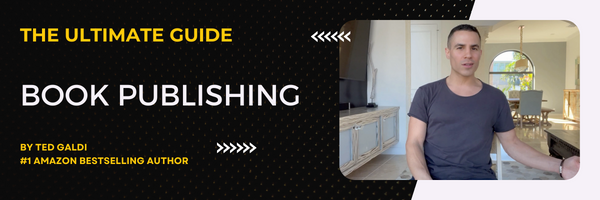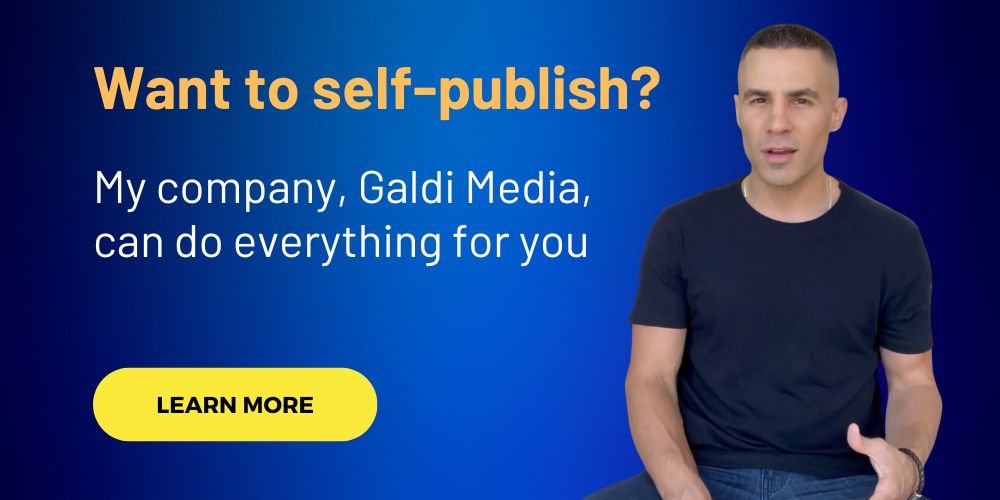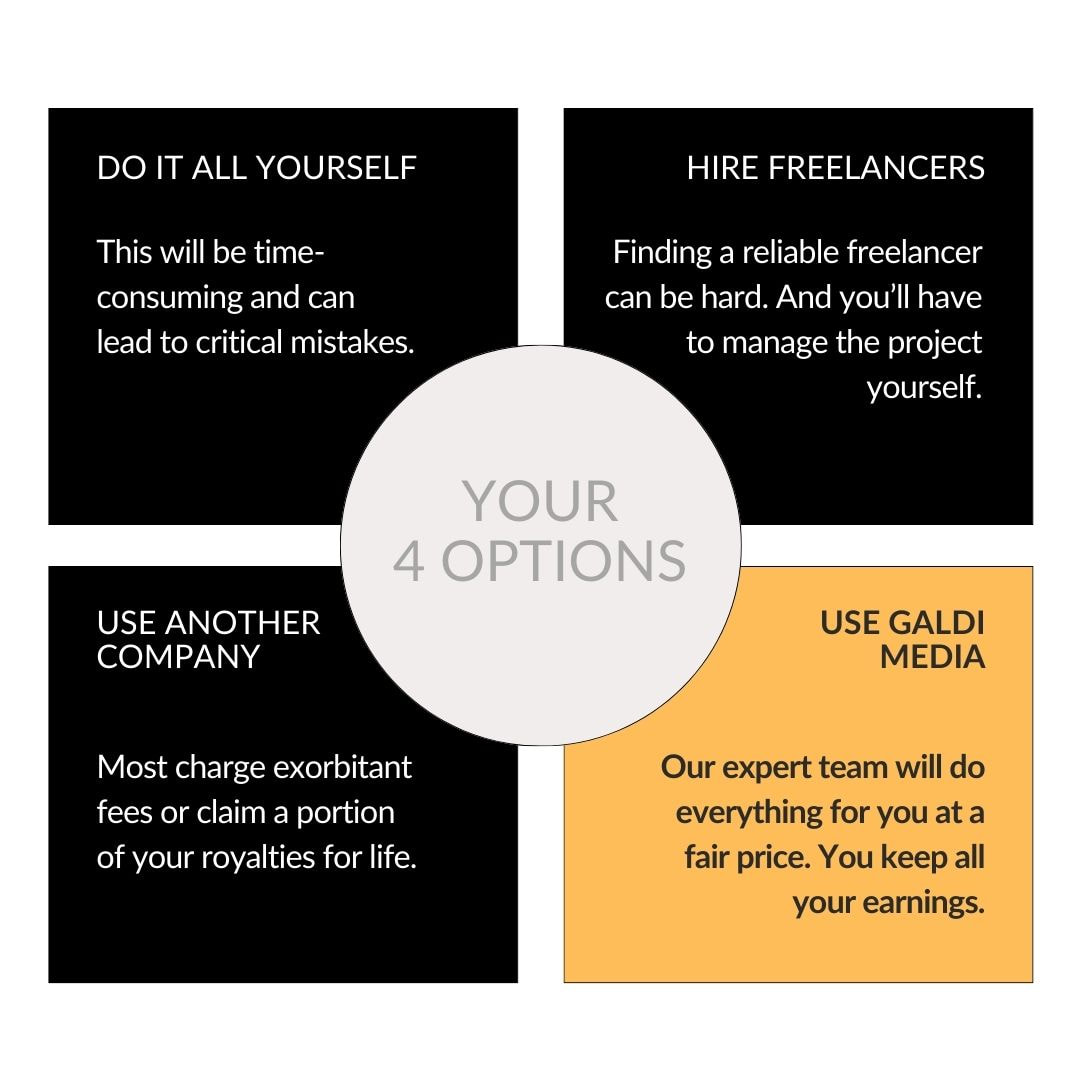The Ultimate Guide on How to Publish a BookWant to publish a book? Learn about the options available to you, get step-by-step guidance for each, and set yourself up for a successful launch. First, write a great bookRegardless of the publishing option you choose, the process will go more smoothly if you've written a great book. First, focus on writing an awesome story. Once you feel your manuscript is in a solid place, then consider your publishing options... Traditional vs. self-publishingWith traditional publishing, a publishing company will acquire the rights to your manuscript and handle your book's publication and sales strategy. You may receive an advance, an upfront cash payment. Once the book is out, you'd share the royalties with the publisher via a contractually agreed-upon split. With self-publishing, also known as indie publishing, you'd be responsible for turning your manuscript into a book and submitting it for sale to retailers. You will have to go out of pocket for various necessary expenses, however, you can keep 100% of the royalties. The pros and cons of traditional publishingThe advantages of traditional publishing for authors:
The disadvantages of traditional publishing for authors:
If you'd like to consider traditional publishing, make a list of possible publishers that would be a good fit for your book. To do that, look up the publishers of various books in your genre. You can find the information on the book's Amazon page, back cover, or Google. Once you have your list of publishers, you want to find their submission requirements, ie how you can give your manuscript to them for assessment. Certain companies allow you to directly submit your manuscript via their website, however, many others only accept submissions from literary agents working on an author's behalf. So, if you're considering the traditional-publishing path, you may need to find a literary agent. To do that, Google the names of various authors in your genre followed by "literary agent." The names of agencies and/or specific agents will come up. Visit their sites and read their submission requirements. Whether you're sending your manuscript to a publisher directly or to literary agents, you should be aware that many submsissions are rejected. If yours happens to be, this does not mean you're a bad writer. Submit to a lot of genre-relevant publishers/agencies and hopefully you find a match. However, many authors wind up getting rejected from everyone they submit to. Again, this does not mean you're a bad writer. However, if this happens, traditional publishing wouldn't be doable for your project. You'd want to consider indie publishing. Other authors skip the traditional-submission process altogether and publish all their titles independently. Learn about this method and see what's best for you... The pros and cons of self-publishingThe advantages of self-publishing for authors:
The disadvantages of independent publishing for authors:
If you're considering the self-publishing path, you should be aware of the major tasks that need to be done before a book goes live:
If you'd like to offer your book as a paperback and/or audiobook, also take into account:
As for marketing, an indie author is responsible for promoting their own book. Yes, it's possible to generate sales using only free marketing (ex, promoting on BookTok), however, paid ads can accelerate your reach. The vast majority of indie authors don't personally do all of the tasks listed above. They rely on specialized professionals for help. Yes, they come at a cost. However, as mentioned, an indie author can keep 100% of a book's royalties. So, if your book does well, you can easily pay yourself back, plus turn a big profit. You have four main options for completing the various self-publishing tasks: If you want to self-publish a successful book at a fair price, without having to do the work yourself, let my company, Galdi Media, handle your project Self-publishing firms vs. freelancersAn all-in-one self-publishing firm like Galdi Media can handle the necessary tasks to launch your book, such as editing, cover design, and file formatting. We'll give you what you need to add to Amazon's self-publishing platform, KDP (Kindle Direct Publishing), assuring it meets all requirements. However, unlike other companies that offer similar services, we let you keep 100% of your royalties. With freelancers, you'd hire various professionals to take care of certain aspects of your book's launch. For instance, someone can design your cover while someone else formats your manuscript for paperback printing. The advantage of a self-publishing firm over freelancers is that it serves as a single point of contact for the entire publishing process. If you'd like, you can step back, have the firm complete every step of the process for you, and then simply check their work for approval. If this option seems appealing to you, I recommend a self-publishing package from Galdi Media. Below, I offer more detail on the steps involved in self-publishing. If you feel you can effectively do any yourself, you can, while letting Galdi Media handle the rest. Editing for self-published booksManuscript editing is a crucial step of the publishing process. An indie author who puts out an unedited book for sale will come off as an amateur if readers notice issues like plot holes or excessive typos and mention them in reviews. People who read the reviews likely won't buy the book and people who wrote the reviews likely won't buy your next book. Even if you're a great self-editor, I strongly suggest you bring in at least one professional to go through your manuscript with an outside perspective. Four types of editing exist. Ideally, you'd want an editor, or multiple editors, to address your manuscript with all four kinds:
To learn more about each, check out my guide to book editing. Editing services are priced by the length of your manuscript. To avoid coming off as an amateur, you should absolutely take on the cost. To save you money, at Galdi Media, a single editor will do all the types of editing for you as part of one project. This is much cheaper than hiring multiple editors for each stage. Cover design for self-published booksThe majority of self-published books are sold on Amazon. The main avenues Amazon uses to market books - search results, on-site recommendations, email recommendations, and ads - all heavily feature covers. So, if your cover isn't high quality, your book will be at a severe disadvantage on Amazon, in addition to other major retailers. Tips for an effective book cover:
Unless you've worked as a professional graphic designer at some point, I'd strongly suggest you do not design your own cover. A subpar cover is the quickest way an author can come off as an amateur. If potential readers see a bad cover, they likely not only won't read your book, but not even click your link to read your description. Once you've written down some ideas for your cover, hire a cover designer and share your thoughts with them. Provide links to books in your niche you've identified. A good designer can take this information and create various options for you. Once you choose an option and provide your feedback, the designer will take a second pass, integrating your input. Likely, you'd do one more round of nuanced feedback and updates, and then your cover will be done. Check out Galdi Media's book cover design service. E-book file formatting for self-published booksOnce you've worked with editor(s) to arrive at the final draft of your manuscript, you need to convert it from your word-processing program into an appropriate file type for e-readers (Kindles, Nooks, iPads, etc). The primary file type for e-books is known as an ePub. It's compatible with all the major retailers and their associated e-readers. When creating an ePub file, you must achieve consistency in the style of your chapter headings and the spacing between chapters. If your book contains illustrations, charts, or other graphics, they need to be optimized for clarity. Fortunately, easy-to-use software systems enable you to format your files yourself. I recommend a tool called Vellum. Or, you can let my team at Galdi Media format your e-book for you. Retailer submissions for self-published booksAs stated, most self-published books are sold on Amazon. The company offers authors a program known as KDP Select, which grants you special promotional opportunities in exchange for giving Amazon exclusive sales rights to the e-book format of the book. To learn more about KDP Select and whether it's a fit for you, check out my post on selling books on Amazon. Though I recommend most authors enroll in KDP Select, if you don't, you can publish your e-book on other platforms too. Here are links to create self-publishing accounts on the major retailers: Regardless of the platform(s) you publish on, before you submit your book, you'll need your final cover file and interior file. Once you have an account on a retailer platform, you should see an option to add a book. You'll be asked to submit your cover and interior files, plus fill out various fields, such as:
If you'd like to choose your own categories and keywords, a tool that can help is Publisher Rocket. If you'd rather not pick your own categories and keywords, or write your own book description, Galdi Media can do this all for you. Self-publishing a paperback bookOnce you've made your e-book version on Amazon's author platform, you can create a paperback. These physical books are printed on-demand, ie when someone orders one, Amazon's printing machines will produce one and it'll be sent off for shipping. As the author, you don't need to worry about managing inventory or mailing copies. Your paperback can be purchased by consumers from Amazon's website. In addition, it'll also become available in catalogs for order by libraries and physical bookstores. So, if you've made a paperback version through Amazon, it can theoretically show up on the shelves of a library or bookstore. Here's what you'll need to create a paperback:
Formatting a paperback on your own, without experience, can be quite tedious. At Galdi Media, we can format a paperback for you. Self-publishing an audiobook on AudibleAudiobook retailer Audible, owned by Amazon, has been growing a lot in popularity. Indie writers can publish audiobooks directly on Audible via its author platform, ACX. Here's what you'll need to create an audiobook:
If you want to go with a professional narrator, here are your three main options:
Marketing your self-published bookNow you know what you need to independently publish an e-book, paperback, and audiobook. However, simply publishing a book doesn't mean it'll generate sales. You also need to market it. Various marketing strategies are at your disposal, some free, some paid. Learn about them next in my ultimate guide to book marketing. This post contains affiliate links.
0 Comments
Leave a Reply. |




 RSS Feed
RSS Feed